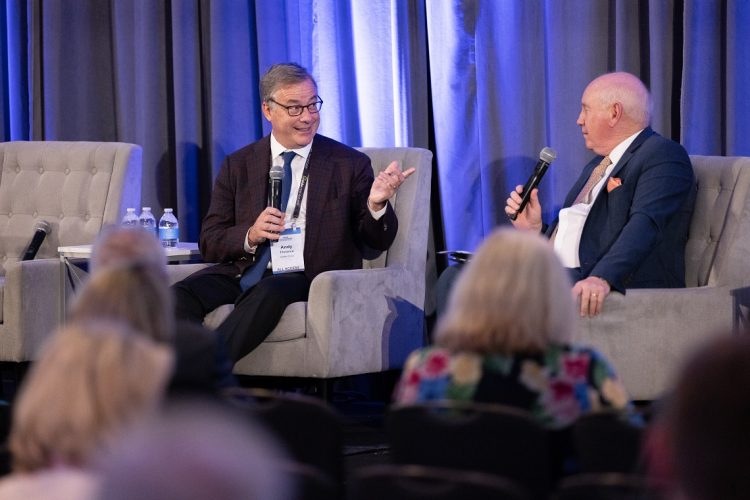Above, Andy Florance, left, Founder and CEO of CoStar Group, talks with RISMedia Founder and CEO John Featherston at RISMedia’s 35th Annual CEO & Leadership Exchange on Sept. 6. Photo by AJ Canaria.
If there’s one thing that industry executives can agree on, it’s that there are way too many variables regarding real estate portals than would allow for a pro or con consensus. Which is logical, given how listing portals have in the last decade or so become pivotal components of the residential real estate space.
In two discussions at RISMedia’s recent CEO & Leadership Exchange, in Washington, D.C., RISMedia Founder and CEO John Featherston first engaged CoStar Group Founder and CEO Andy Florance for his views on “Who Will Win the Portal Challenge and Why.” Following this candid, one-on-one conversation, in a session titled “How Portals Are Changing the Real Estate Playing Field,” six panelists from companies representing leading portals and related businesses thrusted and parried points of view while Featherston skillfully directed traffic.
Unpacking the evolution of Homes.com

In the opening session, Florance discussed the evolution and future plans of CoStar’s residential portal, Homes.com, highlighting its impressive growth. The site now boasts 46 million unique visitors, a 560% year-over-year increase. He also discussed Homes.com’s forthcoming subscription model, which aims to be more inclusive and less expensive than competitors, offering free leads to all agents and double the leads for members. Florance also confirmed that CoStar has no plans to enter the real estate brokerage business.
Featherston probed Florance on the model that’s driving Homes.com and differentiating it from the other listing portals.
“It’s my life’s passion to do this kind of thing, and it’s really simple,” said Florance. “We’re building a better website. The heart is, ‘your listing, your lead’ and it’s pretty straightforward. The buyers want to talk to someone who knows the listing best. Sellers want the person to get through to someone who’s informed. They don’t want the buyer to go into a call center and be moved around to various agents.
“We think we’re about 40% faster than other sites,” Florance noted. “We focus a lot on the UX design—it’s got to look beautiful. We’ve thrown out all the spam ads. Think about it. You’ve got a million-dollar listing, and you work really hard to photograph it…and there’s a diaper ad and a minivan ad next to your million-dollar listing. That’s stupid. We’re adding great content around the neighborhood, schools, parks and condos, and four valuation models. We’ve got over a thousand people working on it.”
Featherston asked Florance to expound upon the growth at Homes.com.
“We just closed last month at 46 million unique visitors, a 560% (increase) year-over-year,” said Florance. “And that’s in a field in which the other portals are declining or flat. So we’re rocketing up, and it’s because people like the site, and we are investing in the portal as we always do, but we’re also getting 600% year-over-year organic growth.
“So that takes us from number five in the industry last November to where we’re now clearly number two. And we’re still growing. What does that mean to agents? It means a lot. We’re tracking about 700,000 leads a month going through call tracking and lead generation. We think these leads convert at a higher rate because you’re not getting thrown to a call center—you’re getting to the listing agent who knows the listing well. So it’s about a one in 10 conversion, and that applies to 70,000 transactions per month, and about a billion dollars in commission value a month.”
Next was CoStar’s subscription model. Featherston posited that Real Estate magazine and RISMedia website readers would find that topic particularly interesting. Florance was happy to go into detail.
“Building these portals is incredibly expensive; it requires billions,” he stressed. “You can set up a site and bring some traffic. Nestfully is a beautiful site, but it doesn’t have the capital to invest. I think it does 5,000 (visitors) a month, which is 161 a day. We did four million yesterday. You have to pay for this stuff. So what Zillow does is charge 3% – 5% of the agents a lot of money.
“Ours is a subscription model where we’re trying to sell something that’s a couple hundred dollars a month instead of like a hundred thousand a year. So we’re going to be much less expensive, much more inclusive—something that more than half of the agents can take advantage of at a lower price point. All the agents will get free leads off of our site, but folks who are members for a couple hundred bucks a month will get twice as many leads because we have a bunch of tactics and strategies for email marketing, for presentation on site, highlighting people around different content and retargeting to generate more lead value.”
Asked when the subscription model would go live, Florance guesstimated sometime next year.
The MLSs: friend or foe?
Featherston next brought up a ticklish point.
“MLSs are the backbone of our industry. They are how we collect data; it’s how we share data; it’s how we protect data,” said Featherston. “And everyone in this audience, the success of their business is predicated on the strength of their MLSs. How are you interacting, and how do you see CoStar interacting with MLSs? Are they foe, or are they friend?”
“MLSs are fantastic,” Florance asserted. “We have hundreds and hundreds of people building content that, if we didn’t have the MLSs, we wouldn’t be able to build. So we love the MLSs, and I don’t think many people understand it, but the MLS is very different from a portal. They have nothing related to one another. One is demand generation from consumers, while the other is a professional agent environment, and they work together.
“It’s a symbiotic relationship. It’s important to have both. They coexist together, and they couldn’t be more different. I don’t see anyone in an MLS saying, ‘hey, let’s invest a billion dollars this year on a portal.’”
In the finale, Featherston asked Florance flat out about CoStar’s plans, especially as it related to residential real estate.
“I’m not asking for a futuristic statement, but over the next two to five years, is CoStar going to be in the brokerage business?” he asked. “I’m talking about being a competitive broker, trying to get a slice of the commission through referral fees.”
“Absolutely not,” said Florance. “It’s important to understand that I’ve had this question for 37 years in a row, and here we are at year 37. And I’ll answer it the same way—and I’m not going to give you two to five years, I’m going to give you 37 years forward. Absolutely no interest.”

Portal execs duke it out
Following Florance’s one-on-one, Featherston led a panel discussing featuring some of the portal environment’s biggest players. “How Portals Are Changing the Real Estate Playing Field,” was fittingly launched with Bob Hale, president and CEO of the Houston Association of REALTORS®, voicing the first viewpoint.
“Our motto since 1997 has been ‘your listing, your lead,’” he began in retort to Florance’s claim to the concept as a differentiator. “So we’ve done that. There’s a problem with it though, because often, a listing agent doesn’t respond to the request of a potential buyer, and that lead goes unanswered. And the buyers get mad at us. They say your website doesn’t work. Well, it’s not us. So that’s a dilemma that the industry has to figure out; this person wants to buy a house and the REALTOR® won’t respond. It’s really a huge problem.”
REALTOR® versus portal?

Featherston asked Cindy Ariosa, senior VP and regional manager at Long & Foster Real Estate, and current chair of Bright MLS, whether real estate portals have made it a better experience for homebuyers, and what else they could be doing to help the consumer. She acknowledged their growing presence in the marketplace, but wasn’t convinced they were a positive force, instead maintaining that they often muddied the waters with inaccurate home prices, sometimes dramatically so, making things tougher for local agents.
“We’ve got 15-plus years of them impacting our industry, but I think it’s a more confusing experience,” she said. “We educate our agents on how to go into listing appointments, and yes, the consumer absolutely puts their eyeballs on the portals, just like we used to go through newspaper ads with all the houses on the market. But the dialogue is not always favorable because they’ve got a number (from the portal) but only the area expert knows exactly what the accurate comparables are.
“We partner with the MLSs so that we have accurate data,” she continued. “I have two grown children looking for homes. They think they’re experts in everything because they’ve grown up on the internet. So every time they see a house, they’ll call me and argue about the value. I’ll pull up the stats from MLSs, and they’ll wonder why it would have a (portal) estimate of $550,000 when the price is $800,000. And I’ll ask, did you drive by the house and see the new addition they put on the back?
“So that is part of the challenge we have,” said Ariosa. “The consumers, both buyers and sellers, are still relying on the REALTOR® as the neighborhood expert with the accurate data, and the one who can help them get to the finish line. Unless you’re using technology and AI and predictive analytics, estimates are going to continue to be inaccurate. There’s a place for portals, and we’ve partnered with them in a lot of places, but I don’t think they’ve taken us to the next level. We’ve had these portals for 15 years, and according to the National Association of REALTORS® (NAR), 90% of consumers are still using REALTORS®.”
Hale pointed out that in an har.com survey, many respondents said the reason they used Zillow and other portals was because “they don’t trust the agent to show them all the homes they want to see, so they go find a home online and then contact the agent. It was kind of brutal. They also said they trust Zillow more than anybody because it’s an independent entity that they believe cares about the consumer.”
Expounding on Zillow’s growing popularity was Curt Beardsley, the portal’s vice president of industry development, who stressed that millennials, the 25 – 40-year-olds, were now major homebuyers, and having grown up in the digital age, are looking to glean information the way they’re used to.
“Almost 70% of all buyers and sellers, those in the home marketplace, are on one of Zillow’s sites during their experience,” he said. “So they obviously find something of value there, and they found that value through the connection with our agent partners that help them through the rest of the transaction. Millennials used to be the subject of every conversation about five years ago, but they kind of drifted off. Now more of them are homeowners than renters.
“A lot of us remember a time before the digital age, but the millennials have grown up in it,” Beardsley continued. “So they’re coming to us as a portal with different expectations and different demands. They want more immersive experiences when they look at the listings, and are 100% dedicated to their phones. If they can’t have that experience on their phone, they don’t want it. So we’re digging into listing media services where through a set of photos we can actually do digital walkthroughs. We also have the ability with our platform to do a transfer directly to a loan officer. So our agent connection, our consumer and our loan officer are all connected to be able to push that person forward.
“And they want to make sure they see all the inventory. They don’t understand the artificial blocks of what’s in the MLSs versus what is new construction, option listings and for sale by owners. They want a comprehensive view of the marketplace, especially when inventory is low.”

Can the MLSs compete?
Featherston then turned to Art Carter, CEO of California Regional MLS, inquiring about data-security measures and also how a modern MLS can better serve the needs of the real estate community while competing with portals.
“Obviously with what happened with Rapattoni, when it comes to data security, we’re all at risk,” said Carter. “There are things a lot of organizations don’t do that they should be doing. Number one, partner with people who understand data security. At a bare minimum, MLSs should be doing security audits every year, and changing their security audit team every year. They should also be heavily invested in a disaster recovery plan.”
Carter admitted that, financially, regional MLSs cannot compete with national portals due to the financial disparity, but they can still profit.
“Leads are great, but the MLSs are where leads come to be turned into sales,” he said. “One of the things that I think that (public portal) Nestfully can do for our brokerage communities and for our agents is really tying back into the MLS experience a lot better than any of the portals are ever going to be able to do. And if we can nail that, I think we will do a good job.”

Security and AI concerns
The dialogue then shifted, with Featherston asking Mehul Patel, VP of product and technology for Constellation1, what role tech plays in enabling portals to serve the needs of buyers and sellers.
“One of the biggest roles we play is to bring new or emerging technology to our portal providers,” said Patel. “Security and trust is a big component. We have to make sure that consumers have an experience in which they know that their search, their data and any kind of information they’re entering is maintained in a secure manner. And we have to have the upkeep, to make sure our portals are responsive and fast, and that we have good, strong disaster recovery plans.
“And then going further from that integration into other emerging technologies—AI is a big one. ChatGPT has a lot of presence in our lives today. So how can we use that? How can we integrate that technology? How can we bring it into a home-search experience? How can we do all of that and yet continue to power the portals to meet the end user’s needs?”

Surviving the competition
How portals compete with each other in the ever-evolving real estate business was addressed by David Mele, president of Homes.com.
“We are convinced that you can’t beat Zillow by trying to be Zillow,” said Mele. “Other portals that have tried to do that are in some ways indistinguishable from Zillow. They’ve converged on a referral-fee model, trying to capture a buyer lead through the entire search process, put them into a call center experience, and then take 30% – 40% of the commission at the end. That’s clearly a model, but it’s not our model. We’re doing something very different in terms of what we’re offering the industry.
“We have our models, an advertising model and a marketing model,” he continued. “So it’s an opportunity for agents to market their listings on Homes.com to get additional exposure. We know that not all agents have listings all the time. So there’s a chance to market yourself, market your agent profile, your expertise in a number of ways, both on Homes.com and beyond. We don’t have to take a dollar or an agent from Zillow. We’re open for the 95% of agents who are not in that walled garden today. It’s a much different business model.”
Hale, with his half-century-plus industry experience, put a bow on the proceedings by pointing out that while portals and other real estate businesses of course compete, there can also be an understanding that they help move each other forward as well.
“Two of our main competitors (Zillow and Homes.com) are sitting right here, but we have a really unique relationship—a friendly, very respectful relationship,” he said. “We work together and share information. We’re competitors, but in a very positive way. Zillow’s new interactive floor plan product is truly unbelievable. And the good news is it doesn’t cost the agent or the broker anything.
“A few days ago I went on Homes.com, and it’s fantastic. They’ve got more local data than all the other sites. You feel like you’re in the neighborhood when you’re on their site. So Zillow and Homes.com have done an incredible job. With thousands of people and a lot of money spent, they do a lot that we can’t do.”













The insights provided are valuable for understanding the dynamics of the real estate market and its online platforms. A great read for anyone interested in the intersection of technology and business!